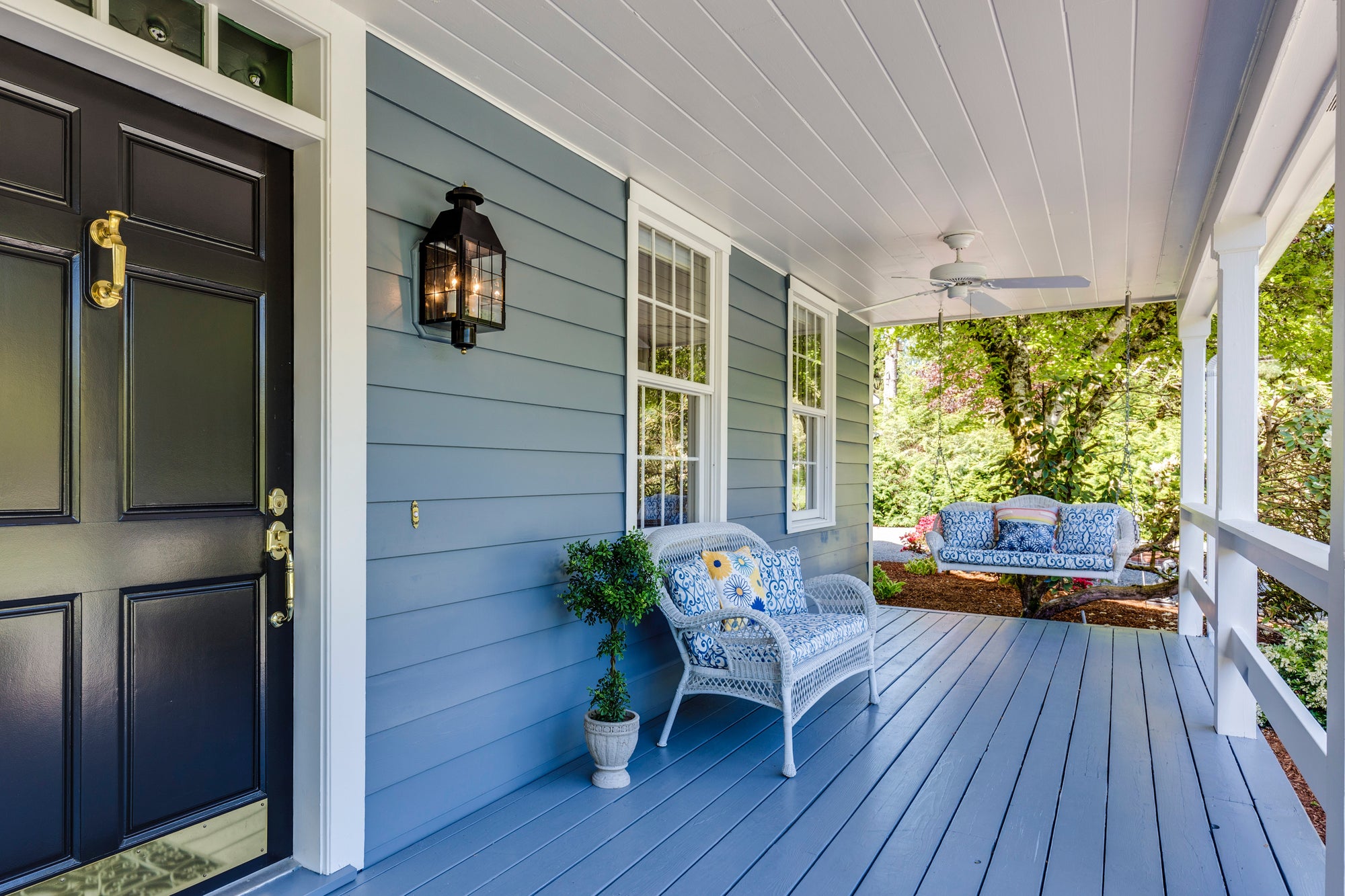
The nostalgic charm of a wooden porch swing adds a touch of whimsy to any home. They harken back to simpler times, which is why they’re a classic piece of outdoor furniture that stands the test of time.
It’s not just the aesthetic that has staying power. While low grade woods like pressure-treated pine tend to warp pretty quickly and whitewood, poplar, and oak decay with time, wooden porch swings crafted from high-quality cypress or cedar can last generations with the proper upkeep.
Like all treasured parts of our home, a wooden porch swing needs a little TLC from time-to-time. Refinishing or restoring a high-quality wooden porch swing is simple and only needs to be touched up every few years, or whenever you want to change the color.
This guide will show you how to add years to the life of your porch swing. The best part is that it can be done in an afternoon with a little sanding, staining, and elbow grease.
Is it Better to Paint or Stain a Wooden Porch Swing? 
Before we dive into the step-by-step porch swing restoration guide, let’s review your options for finishes. It comes down to the choice between paint and stain. It is largely a matter of personal preference, but there are a few considerations to keep in mind before you head to the hardware store.
The biggest consideration is porch swing material. Pine is better painted while hardwearing cypress fares better with stain. Cedar and cypress have natural oils that prevent paint from adhering well long-term. High-quality woods take stain better, which requires less future maintenance because paint has a tendency to chip and fade faster.
Paint is less durable than oils, but is still a good option if it helps you achieve the desired look for your swing. Look for a semi-gloss latex paint, which is sometime labeled “water-based” paint. This type of paint provides ultraviolet protection and expands and contracts with the weather, allowing it to stand up to the elements.
Fun in the Yard recommends reinforcing the latex coat of paint with a gloss sheen. Gloss and semi-gloss products resist scuffs and keep high traffic areas looking smart for longer.
Tools & Materials for Refinishing a Wooden Porch Swing

Is there anything worse than getting home from the store and realizing you forgot something important? When you head to the home improvement store to pick up your stain or paint, make sure you have these tools and materials on your shopping list or handy at-home.
- Palm Sander
- Fine-Grit Sandpaper
- Tack Cloth (for cleaning)
- Paintbrushes
- Cotton Rag
- Gloves
- Safety Glasses & Dust Masks
- Stain or Paint
- Oil-based sealer
Step-by-Step Guide for Refinishing a Wooden Porch Swing

Refinishing a porch swing might sound like a big project to tackle on your own at first, but you’ll be happy to learn that it only takes a few hours to complete the hardest steps in the process. You don’t need to be a carpenter and, in many cases, you don’t need to remove the swing from its mounting — as long as the wood isn’t too rotted out.
In all, the process takes two days. The longest part is waiting for the paint or stain to dry before you can sit back and swing.
Step One: Before any real work begins give the swing a good cleaning. Wipe off dust, dirt, and cobwebs with tack cloth. Or you could use an air compressor to easily remove any loose dirt in no time.
Spraying your swing with a hose usually does the trick for removing bird droppings and other stuck-on dirt, according to Get Set Clean. If you use a pressure washer, just be sure not to have the pressure too high because it could damage the wood. Note that it could take up to 24-hours to dry before you can start working.
Next, take inventory of the state of your porch swing. You’ve probably already noticed some obvious touch up spots in passing, but get a closer look to gauge the project ahead of you to determine if you might need any additional tools or materials.
Check for rot, splinters, and cracked pieces of wood. If something looks a little off, strip off any existing paint to get a better look at the area in question. This is also a good time to spray some WD-40 on any squeaks you hear when you sit down and to replace any worn down screws or nuts and bolts.
Step Two: Time to sand.
Using fine-grit sandpaper and an easy-to-control palm sander, you’ll have your porch swing good as new in a snap. A light sanding with180 grit sandpaper will easily smooth out any splintered edges or rough weathered patches. Sand through the slats gently by hand.
If your swing is painted, sand down the existing coat of paint.
Depending on the condition of your swing, sanding typically doesn’t require more than an hour to complete. If you’re not keen on power tools, a sanding block is effective it will just take you a little longer.
Most heavily worn or damaged pieces can be reinforced, but if you’re unsure it’s best to replace the entire section, according the DIY Network.
Step Three: The last step is applying the stain or paint. Put on nitrile gloves to avoid getting any stain or paint on your skin.
For stain, use a cotton rag and small paint brushes to apply an even coat to the swing. For a clean look go with the grain of the wood. When painting outdoor furniture, smaller brushes and rollers work better than clunkier options.
A common rule of thumb is to use two coats of paint or stain, although consider any instructions on the can, notes the pros at TheHandyMan.com.
Latex paint is dry to the touch in about 1 hour after the last brush stroke, and you re-coat in 4 hours to be on the safe side. Stain takes longer to absorb. It takes a minimum of 24 to 48 hours for wood stain to completely dry. Though you can wait up to 72 hours before applying an oil-based sealer.
We recommend using an oil-based sealer with UV protection to protect the wood and prevent it from fading in the sun. Check the label to ensure the sealants, cleaners, or coating is intended to for your porch swing’s type of wood. In general, it is best to avoid teak oils and varnishes because these finishes could damage the wood’s natural oils that keep the wood free from mildew and rot, and less susceptible to insects.
Now your wooden porch swing is looking fresh and ready to enjoy. Wooden porch swings crafted from high-quality cypress, like Organic Swings, don’t require much upkeep to maintain. We recommend periodically applying oil-based sealer onto the wood over the existing layer to maintain its beauty for years to come.



